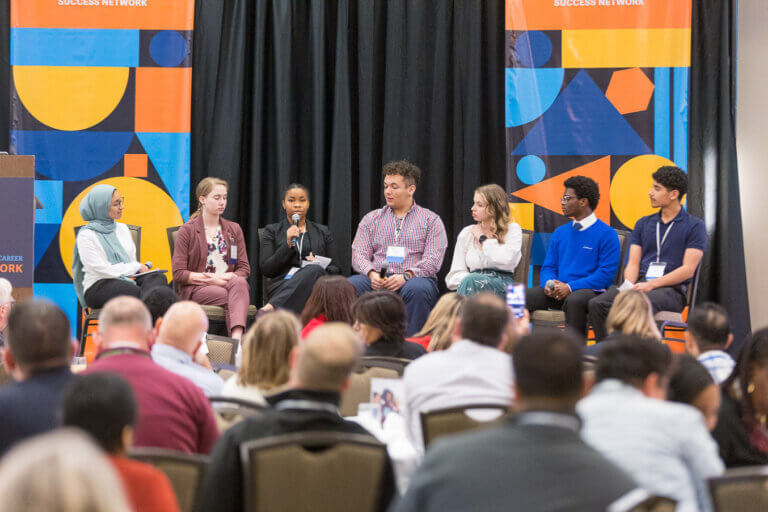The core goal of work-based learning is to provide meaningful and effective learning experiences for our students. How do we know if students find these experiences impactful? One of the most effective ways is by integrating opportunities for student feedback to garner insights that can guide refinements and ensure the experiences evolve to meet the ever-changing needs of our students. Feedback opportunities are especially important for long-term experiences such as youth apprenticeships.
As EdSystems continues to grapple with our commitment to emphasize student feedback opportunities in our youth apprenticeship, we’re asking: How do we effectively gather and utilize this feedback? How do we create an environment where students feel comfortable and empowered to share their thoughts on tasks, projects, mentorship, and post-high school plans? What do we need to know to both support the student in real-time and inform our efforts for continuous improvement of the program for future apprentices?
How Are We Incorporating Student Feedback?
EdSystems is incorporating feedback from youth apprentices in a variety of ways to inform continuous improvement, both immediate and long-term, and ensure the students’ experiences are meaningful. Specific strategies used to gather and act on apprentice feedback include:
Essential Employability Skills Assessments
A key component of the youth apprenticeship program is integrating essential skill reflection and assessments. At the start of the apprenticeship, youth apprentices identify the top three essential skills they want to focus on and receive support for further development. Apprentices will take a pre-, mid-, and final assessment where they will share their reflections and mark their progress as learning, developing, or leading for each skill.
At EdSystems, apprentices join existing project teams based on their areas of interest and project needs. Before joining a project, we clearly outline the specific essential skills that will be core to the work, allowing apprentices to reflect with their project lead on these areas both before and after completing the project.
Engaging apprentices in consistent reflections on their essential skill development helps in monitoring their progress, identifying where they are getting hands-on experience, and highlighting areas where they may need more exposure. To facilitate this process, we utilize GPEAK curricular resources and assessments, which provide a structured framework for both skill development and ongoing reflection. This targeted approach ensures that apprentices cultivate the essential skills that will support their future career success, whether they pursue a career in education policy or not.
Regular Check-Ins
Youth apprentices engage in bi-weekly check-ins with a designated manager. These meetings allow informal conversations about their work as well as critical touchpoints to assess the apprentice’s workload and overall progress. Key questions addressed during these check-ins include:
- Is anything especially interesting and/or challenging?
- How are you feeling about your current project?
- Are you receiving adequate support and resources to complete your work?
The manager also advocates for the apprentice as needed. If the apprentice feels they need more support or are lacking sufficient tasks, the manager can coach them on how to approach the project lead for additional work or guidance. (To help apprentices build their skills in initiative and self-drive, they also have one to two ongoing projects they can turn to when they reach a stopping point in their assigned tasks.)
Annual Feedback Survey
A comprehensive survey offers apprentices the chance to provide detailed recommendations for improvement. This survey is divided into several sections—general experience, recruitment and onboarding, mentorship and support, work experience and responsibilities, and program outcomes and future opportunities. In the past, the manager administered the survey at the end of the school year/summer. This year, we shifted to a quarterly timeframe. By surveying apprentices after three, six, nine, and twelve months, we hope to capture their feedback in real-time, enabling us to track changes in apprentice feedback and make timely adjustments to mentorship, project assignments, or other program components as needed while still capturing insights we can use to inform future years.
How Are You Engaging in Student Feedback Opportunities?
Take a moment to critically examine your youth apprenticeship program or other long-term work-based learning opportunities such as career development experiences. How many opportunities do students have to provide feedback, both formally and informally? Have you made meaningful changes based on their input, or could you be more intentional in this area?
If you’ve collected feedback in the past, take another look. Are you asking the right questions about your program so that students’ feedback can help clarify what’s working and what needs adjustment? Have you made changes based on what you heard, or did those surveys get filed away without driving real improvement?
Building multiple, regular opportunities for students to share their experiences can lead to continuous, impactful program refinement. We encourage you to utilize and adapt the tools and templates we’ve shared from our EdSystems youth apprenticeship program. If you’d like a thought partner in this process, don’t hesitate to reach out. We’re here to help! Reach out using the connect form below.


